Volvo Cars Transition to the Age of Electric Vehicles
VerifiedAdded on 2022/07/27
|15
|3208
|23
AI Summary
READ THE CASE SUPPLIED TITLED ELECTRIC VEHICALS IN EUROPE .Assignment based on case study, so is neccessary to read the study of case attached. Pay attention on the structure of the work FIND IT IN THE FILE -- A1 Global business environment task -- and respect the brief NAMED -- as 1 GBE --
Contribute Materials
Your contribution can guide someone’s learning journey. Share your
documents today.
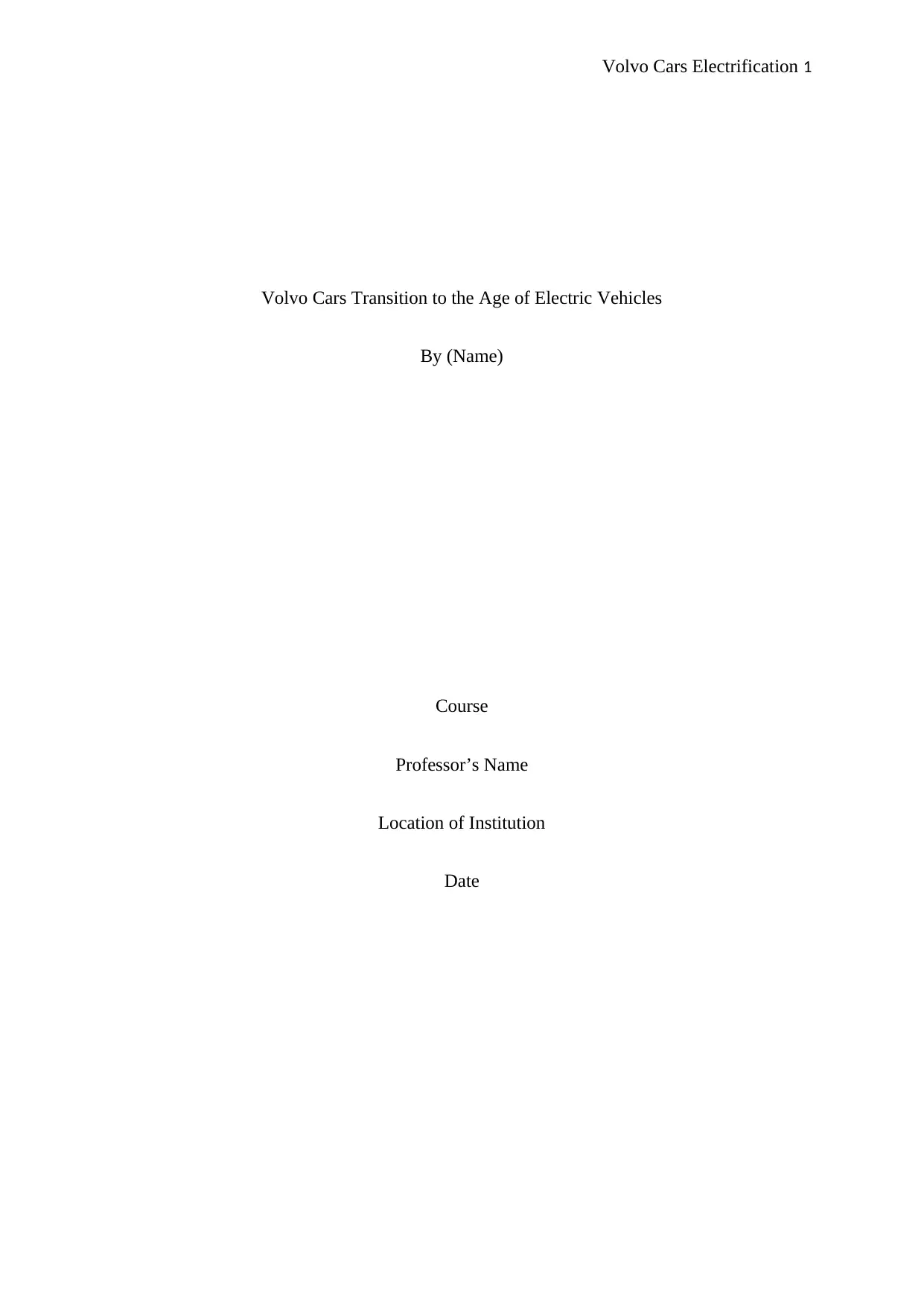
Volvo Cars Electrification 1
Volvo Cars Transition to the Age of Electric Vehicles
By (Name)
Course
Professor’s Name
Location of Institution
Date
Volvo Cars Transition to the Age of Electric Vehicles
By (Name)
Course
Professor’s Name
Location of Institution
Date
Secure Best Marks with AI Grader
Need help grading? Try our AI Grader for instant feedback on your assignments.
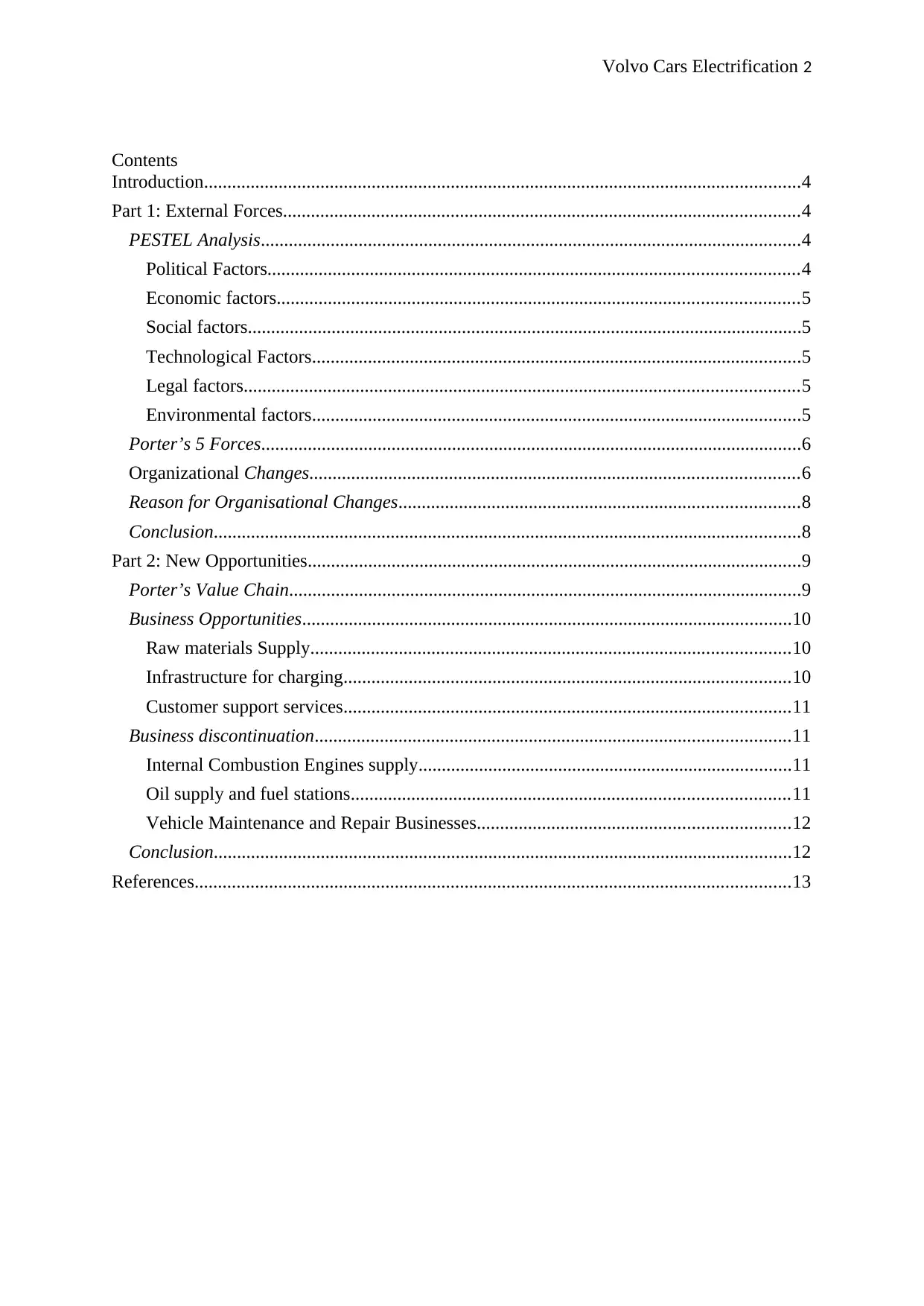
Volvo Cars Electrification 2
Contents
Introduction................................................................................................................................4
Part 1: External Forces...............................................................................................................4
PESTEL Analysis....................................................................................................................4
Political Factors..................................................................................................................4
Economic factors................................................................................................................5
Social factors.......................................................................................................................5
Technological Factors.........................................................................................................5
Legal factors.......................................................................................................................5
Environmental factors.........................................................................................................5
Porter’s 5 Forces....................................................................................................................6
Organizational Changes.........................................................................................................6
Reason for Organisational Changes......................................................................................8
Conclusion..............................................................................................................................8
Part 2: New Opportunities..........................................................................................................9
Porter’s Value Chain..............................................................................................................9
Business Opportunities.........................................................................................................10
Raw materials Supply.......................................................................................................10
Infrastructure for charging................................................................................................10
Customer support services................................................................................................11
Business discontinuation......................................................................................................11
Internal Combustion Engines supply................................................................................11
Oil supply and fuel stations..............................................................................................11
Vehicle Maintenance and Repair Businesses...................................................................12
Conclusion............................................................................................................................12
References................................................................................................................................13
Contents
Introduction................................................................................................................................4
Part 1: External Forces...............................................................................................................4
PESTEL Analysis....................................................................................................................4
Political Factors..................................................................................................................4
Economic factors................................................................................................................5
Social factors.......................................................................................................................5
Technological Factors.........................................................................................................5
Legal factors.......................................................................................................................5
Environmental factors.........................................................................................................5
Porter’s 5 Forces....................................................................................................................6
Organizational Changes.........................................................................................................6
Reason for Organisational Changes......................................................................................8
Conclusion..............................................................................................................................8
Part 2: New Opportunities..........................................................................................................9
Porter’s Value Chain..............................................................................................................9
Business Opportunities.........................................................................................................10
Raw materials Supply.......................................................................................................10
Infrastructure for charging................................................................................................10
Customer support services................................................................................................11
Business discontinuation......................................................................................................11
Internal Combustion Engines supply................................................................................11
Oil supply and fuel stations..............................................................................................11
Vehicle Maintenance and Repair Businesses...................................................................12
Conclusion............................................................................................................................12
References................................................................................................................................13
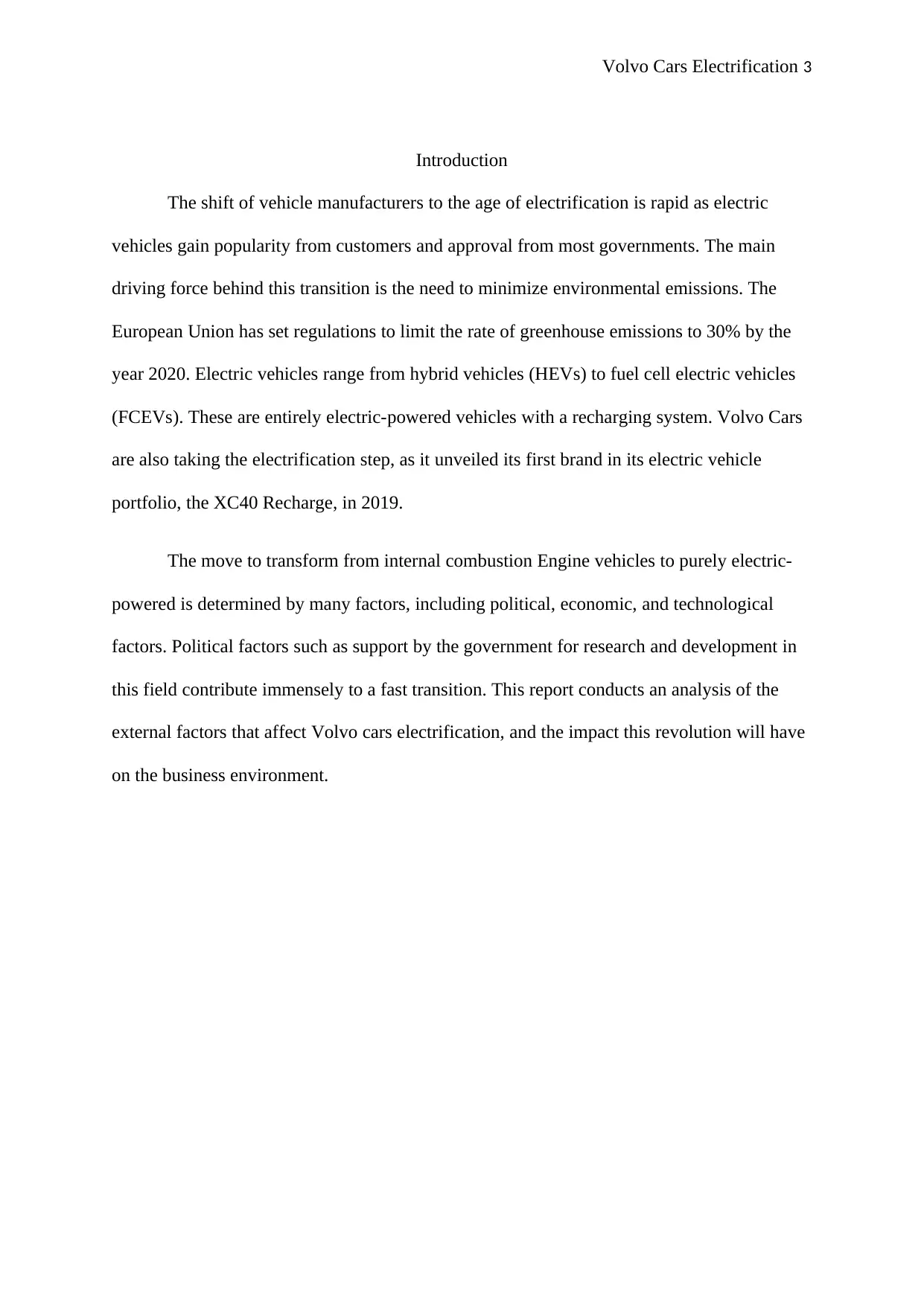
Volvo Cars Electrification 3
Introduction
The shift of vehicle manufacturers to the age of electrification is rapid as electric
vehicles gain popularity from customers and approval from most governments. The main
driving force behind this transition is the need to minimize environmental emissions. The
European Union has set regulations to limit the rate of greenhouse emissions to 30% by the
year 2020. Electric vehicles range from hybrid vehicles (HEVs) to fuel cell electric vehicles
(FCEVs). These are entirely electric-powered vehicles with a recharging system. Volvo Cars
are also taking the electrification step, as it unveiled its first brand in its electric vehicle
portfolio, the XC40 Recharge, in 2019.
The move to transform from internal combustion Engine vehicles to purely electric-
powered is determined by many factors, including political, economic, and technological
factors. Political factors such as support by the government for research and development in
this field contribute immensely to a fast transition. This report conducts an analysis of the
external factors that affect Volvo cars electrification, and the impact this revolution will have
on the business environment.
Introduction
The shift of vehicle manufacturers to the age of electrification is rapid as electric
vehicles gain popularity from customers and approval from most governments. The main
driving force behind this transition is the need to minimize environmental emissions. The
European Union has set regulations to limit the rate of greenhouse emissions to 30% by the
year 2020. Electric vehicles range from hybrid vehicles (HEVs) to fuel cell electric vehicles
(FCEVs). These are entirely electric-powered vehicles with a recharging system. Volvo Cars
are also taking the electrification step, as it unveiled its first brand in its electric vehicle
portfolio, the XC40 Recharge, in 2019.
The move to transform from internal combustion Engine vehicles to purely electric-
powered is determined by many factors, including political, economic, and technological
factors. Political factors such as support by the government for research and development in
this field contribute immensely to a fast transition. This report conducts an analysis of the
external factors that affect Volvo cars electrification, and the impact this revolution will have
on the business environment.

Volvo Cars Electrification 4
Part 1: External Forces
PESTEL Analysis
Political Factors
Most European governments support the development and sale of electric vehicles.
They offer funds for research and development in this field. Electric vehicle owners are
provided free parking spaces and even tax exemptions (Masiero et al., 2016). This is an
opportunity for Volvo cars as government incentives encourage more customers to purchase
electric vehicles, thus widening the market. Other political factors include:
Global declarations (opportunity)
Trade policies (opportunity and threat)
Economic factors
Increasing demand for electric vehicles (opportunity) (Yang et al., 2018).
Decreasing the cost of batteries and charging stations (opportunity).
The increasing cost of fossil fuel. (opportunity)
Social factors
Rise in urban population density (opportunity).
Increasing knowledge of environmental conservation (opportunity) (Chu et al., 2018).
Covid-19 pandemic (threat)
Technological Factors
Rising innovations in battery technology (opportunity) (Miao et al., 2019).
Innovations in information technology (opportunity and threat).
Rise in automation technology (opportunity)
Part 1: External Forces
PESTEL Analysis
Political Factors
Most European governments support the development and sale of electric vehicles.
They offer funds for research and development in this field. Electric vehicle owners are
provided free parking spaces and even tax exemptions (Masiero et al., 2016). This is an
opportunity for Volvo cars as government incentives encourage more customers to purchase
electric vehicles, thus widening the market. Other political factors include:
Global declarations (opportunity)
Trade policies (opportunity and threat)
Economic factors
Increasing demand for electric vehicles (opportunity) (Yang et al., 2018).
Decreasing the cost of batteries and charging stations (opportunity).
The increasing cost of fossil fuel. (opportunity)
Social factors
Rise in urban population density (opportunity).
Increasing knowledge of environmental conservation (opportunity) (Chu et al., 2018).
Covid-19 pandemic (threat)
Technological Factors
Rising innovations in battery technology (opportunity) (Miao et al., 2019).
Innovations in information technology (opportunity and threat).
Rise in automation technology (opportunity)
Secure Best Marks with AI Grader
Need help grading? Try our AI Grader for instant feedback on your assignments.
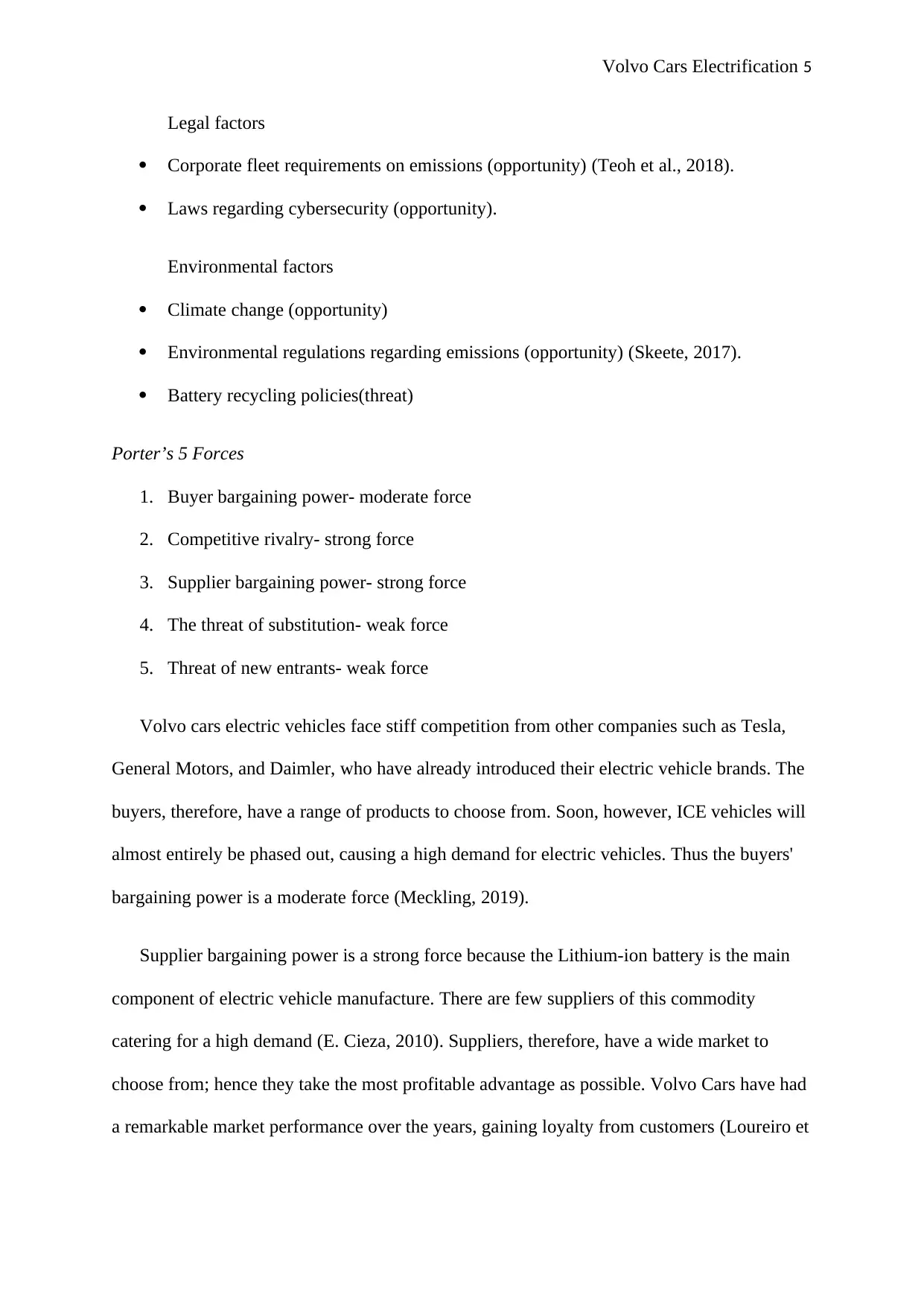
Volvo Cars Electrification 5
Legal factors
Corporate fleet requirements on emissions (opportunity) (Teoh et al., 2018).
Laws regarding cybersecurity (opportunity).
Environmental factors
Climate change (opportunity)
Environmental regulations regarding emissions (opportunity) (Skeete, 2017).
Battery recycling policies(threat)
Porter’s 5 Forces
1. Buyer bargaining power- moderate force
2. Competitive rivalry- strong force
3. Supplier bargaining power- strong force
4. The threat of substitution- weak force
5. Threat of new entrants- weak force
Volvo cars electric vehicles face stiff competition from other companies such as Tesla,
General Motors, and Daimler, who have already introduced their electric vehicle brands. The
buyers, therefore, have a range of products to choose from. Soon, however, ICE vehicles will
almost entirely be phased out, causing a high demand for electric vehicles. Thus the buyers'
bargaining power is a moderate force (Meckling, 2019).
Supplier bargaining power is a strong force because the Lithium-ion battery is the main
component of electric vehicle manufacture. There are few suppliers of this commodity
catering for a high demand (E. Cieza, 2010). Suppliers, therefore, have a wide market to
choose from; hence they take the most profitable advantage as possible. Volvo Cars have had
a remarkable market performance over the years, gaining loyalty from customers (Loureiro et
Legal factors
Corporate fleet requirements on emissions (opportunity) (Teoh et al., 2018).
Laws regarding cybersecurity (opportunity).
Environmental factors
Climate change (opportunity)
Environmental regulations regarding emissions (opportunity) (Skeete, 2017).
Battery recycling policies(threat)
Porter’s 5 Forces
1. Buyer bargaining power- moderate force
2. Competitive rivalry- strong force
3. Supplier bargaining power- strong force
4. The threat of substitution- weak force
5. Threat of new entrants- weak force
Volvo cars electric vehicles face stiff competition from other companies such as Tesla,
General Motors, and Daimler, who have already introduced their electric vehicle brands. The
buyers, therefore, have a range of products to choose from. Soon, however, ICE vehicles will
almost entirely be phased out, causing a high demand for electric vehicles. Thus the buyers'
bargaining power is a moderate force (Meckling, 2019).
Supplier bargaining power is a strong force because the Lithium-ion battery is the main
component of electric vehicle manufacture. There are few suppliers of this commodity
catering for a high demand (E. Cieza, 2010). Suppliers, therefore, have a wide market to
choose from; hence they take the most profitable advantage as possible. Volvo Cars have had
a remarkable market performance over the years, gaining loyalty from customers (Loureiro et
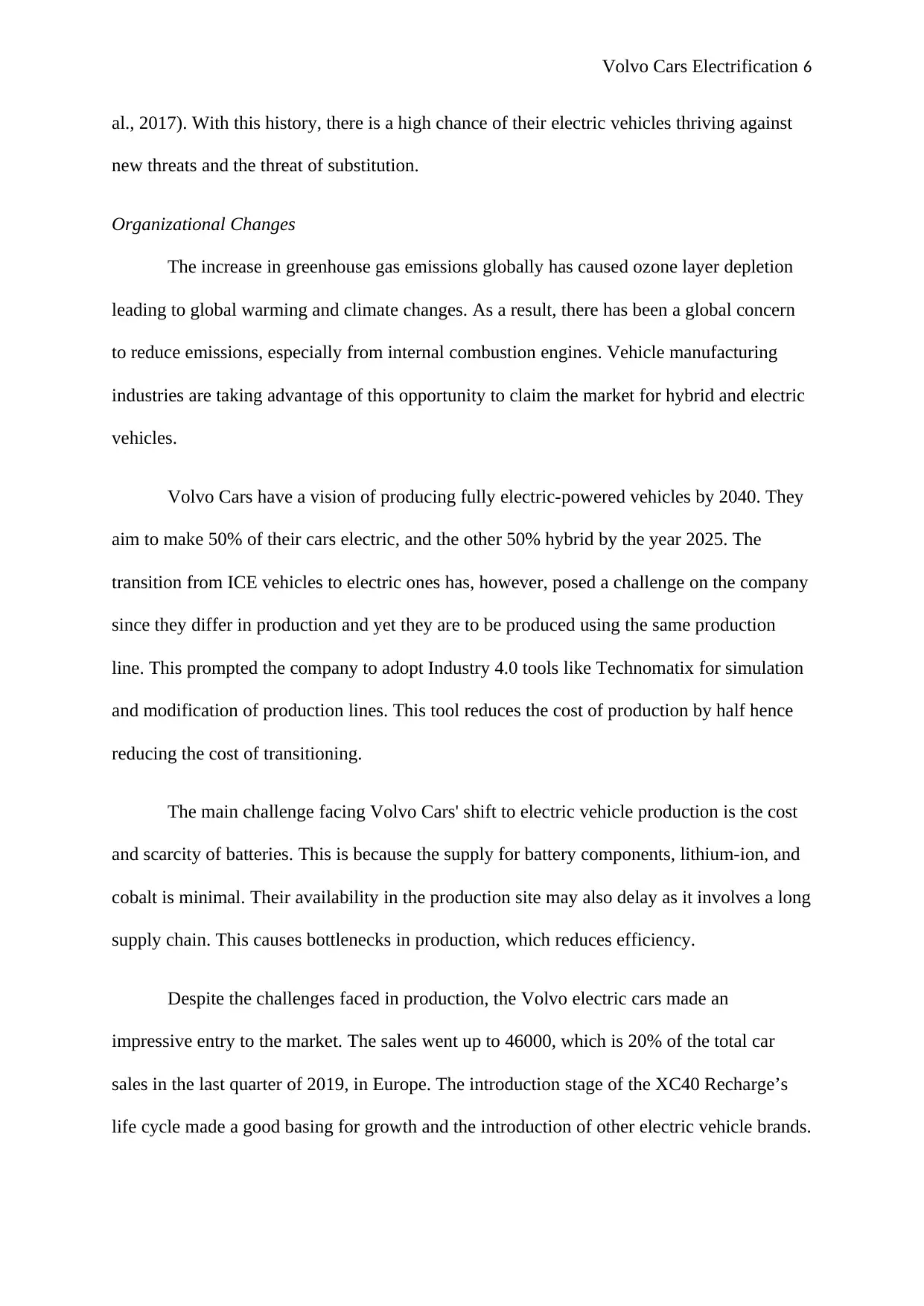
Volvo Cars Electrification 6
al., 2017). With this history, there is a high chance of their electric vehicles thriving against
new threats and the threat of substitution.
Organizational Changes
The increase in greenhouse gas emissions globally has caused ozone layer depletion
leading to global warming and climate changes. As a result, there has been a global concern
to reduce emissions, especially from internal combustion engines. Vehicle manufacturing
industries are taking advantage of this opportunity to claim the market for hybrid and electric
vehicles.
Volvo Cars have a vision of producing fully electric-powered vehicles by 2040. They
aim to make 50% of their cars electric, and the other 50% hybrid by the year 2025. The
transition from ICE vehicles to electric ones has, however, posed a challenge on the company
since they differ in production and yet they are to be produced using the same production
line. This prompted the company to adopt Industry 4.0 tools like Technomatix for simulation
and modification of production lines. This tool reduces the cost of production by half hence
reducing the cost of transitioning.
The main challenge facing Volvo Cars' shift to electric vehicle production is the cost
and scarcity of batteries. This is because the supply for battery components, lithium-ion, and
cobalt is minimal. Their availability in the production site may also delay as it involves a long
supply chain. This causes bottlenecks in production, which reduces efficiency.
Despite the challenges faced in production, the Volvo electric cars made an
impressive entry to the market. The sales went up to 46000, which is 20% of the total car
sales in the last quarter of 2019, in Europe. The introduction stage of the XC40 Recharge’s
life cycle made a good basing for growth and the introduction of other electric vehicle brands.
al., 2017). With this history, there is a high chance of their electric vehicles thriving against
new threats and the threat of substitution.
Organizational Changes
The increase in greenhouse gas emissions globally has caused ozone layer depletion
leading to global warming and climate changes. As a result, there has been a global concern
to reduce emissions, especially from internal combustion engines. Vehicle manufacturing
industries are taking advantage of this opportunity to claim the market for hybrid and electric
vehicles.
Volvo Cars have a vision of producing fully electric-powered vehicles by 2040. They
aim to make 50% of their cars electric, and the other 50% hybrid by the year 2025. The
transition from ICE vehicles to electric ones has, however, posed a challenge on the company
since they differ in production and yet they are to be produced using the same production
line. This prompted the company to adopt Industry 4.0 tools like Technomatix for simulation
and modification of production lines. This tool reduces the cost of production by half hence
reducing the cost of transitioning.
The main challenge facing Volvo Cars' shift to electric vehicle production is the cost
and scarcity of batteries. This is because the supply for battery components, lithium-ion, and
cobalt is minimal. Their availability in the production site may also delay as it involves a long
supply chain. This causes bottlenecks in production, which reduces efficiency.
Despite the challenges faced in production, the Volvo electric cars made an
impressive entry to the market. The sales went up to 46000, which is 20% of the total car
sales in the last quarter of 2019, in Europe. The introduction stage of the XC40 Recharge’s
life cycle made a good basing for growth and the introduction of other electric vehicle brands.
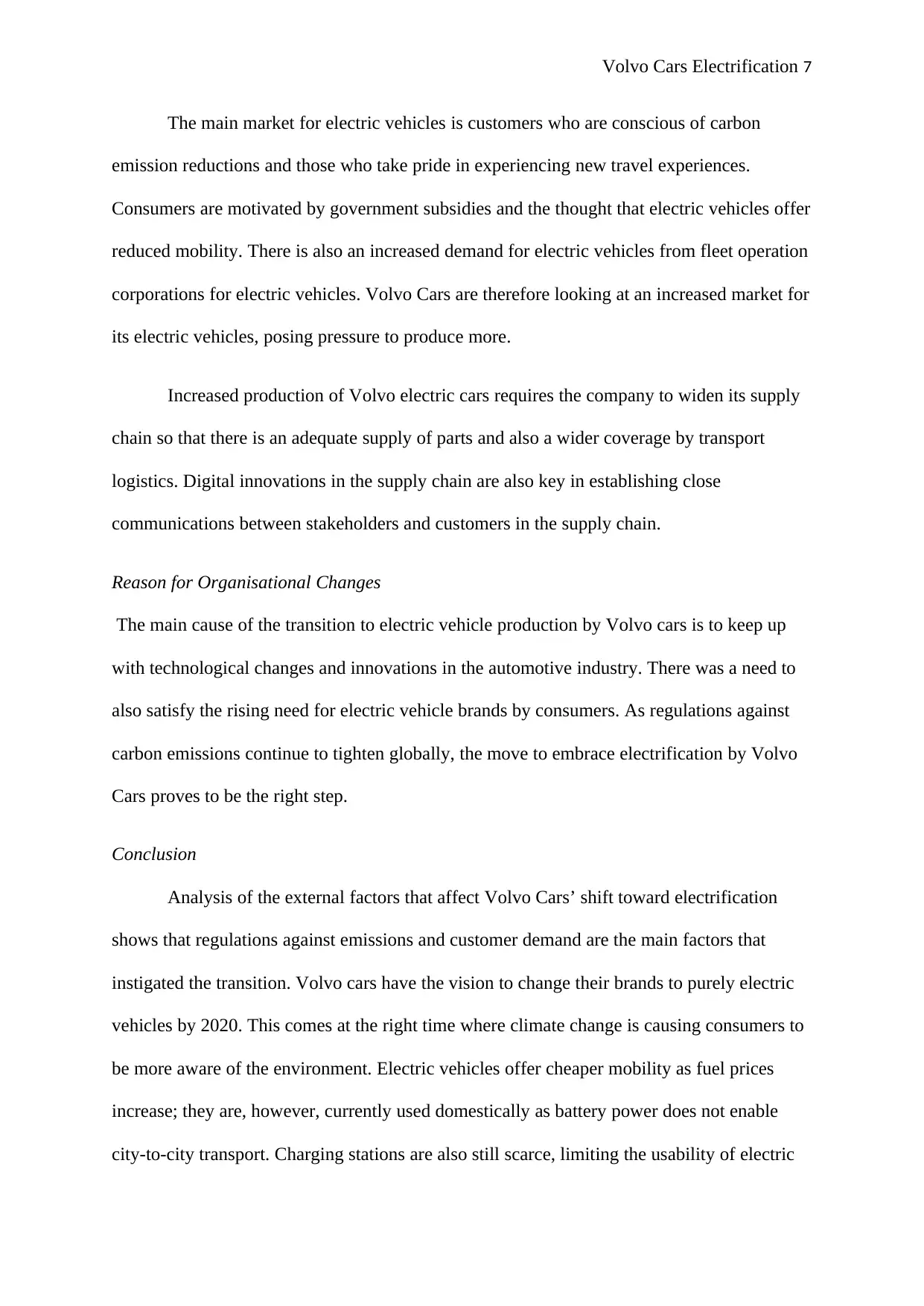
Volvo Cars Electrification 7
The main market for electric vehicles is customers who are conscious of carbon
emission reductions and those who take pride in experiencing new travel experiences.
Consumers are motivated by government subsidies and the thought that electric vehicles offer
reduced mobility. There is also an increased demand for electric vehicles from fleet operation
corporations for electric vehicles. Volvo Cars are therefore looking at an increased market for
its electric vehicles, posing pressure to produce more.
Increased production of Volvo electric cars requires the company to widen its supply
chain so that there is an adequate supply of parts and also a wider coverage by transport
logistics. Digital innovations in the supply chain are also key in establishing close
communications between stakeholders and customers in the supply chain.
Reason for Organisational Changes
The main cause of the transition to electric vehicle production by Volvo cars is to keep up
with technological changes and innovations in the automotive industry. There was a need to
also satisfy the rising need for electric vehicle brands by consumers. As regulations against
carbon emissions continue to tighten globally, the move to embrace electrification by Volvo
Cars proves to be the right step.
Conclusion
Analysis of the external factors that affect Volvo Cars’ shift toward electrification
shows that regulations against emissions and customer demand are the main factors that
instigated the transition. Volvo cars have the vision to change their brands to purely electric
vehicles by 2020. This comes at the right time where climate change is causing consumers to
be more aware of the environment. Electric vehicles offer cheaper mobility as fuel prices
increase; they are, however, currently used domestically as battery power does not enable
city-to-city transport. Charging stations are also still scarce, limiting the usability of electric
The main market for electric vehicles is customers who are conscious of carbon
emission reductions and those who take pride in experiencing new travel experiences.
Consumers are motivated by government subsidies and the thought that electric vehicles offer
reduced mobility. There is also an increased demand for electric vehicles from fleet operation
corporations for electric vehicles. Volvo Cars are therefore looking at an increased market for
its electric vehicles, posing pressure to produce more.
Increased production of Volvo electric cars requires the company to widen its supply
chain so that there is an adequate supply of parts and also a wider coverage by transport
logistics. Digital innovations in the supply chain are also key in establishing close
communications between stakeholders and customers in the supply chain.
Reason for Organisational Changes
The main cause of the transition to electric vehicle production by Volvo cars is to keep up
with technological changes and innovations in the automotive industry. There was a need to
also satisfy the rising need for electric vehicle brands by consumers. As regulations against
carbon emissions continue to tighten globally, the move to embrace electrification by Volvo
Cars proves to be the right step.
Conclusion
Analysis of the external factors that affect Volvo Cars’ shift toward electrification
shows that regulations against emissions and customer demand are the main factors that
instigated the transition. Volvo cars have the vision to change their brands to purely electric
vehicles by 2020. This comes at the right time where climate change is causing consumers to
be more aware of the environment. Electric vehicles offer cheaper mobility as fuel prices
increase; they are, however, currently used domestically as battery power does not enable
city-to-city transport. Charging stations are also still scarce, limiting the usability of electric
Paraphrase This Document
Need a fresh take? Get an instant paraphrase of this document with our AI Paraphraser
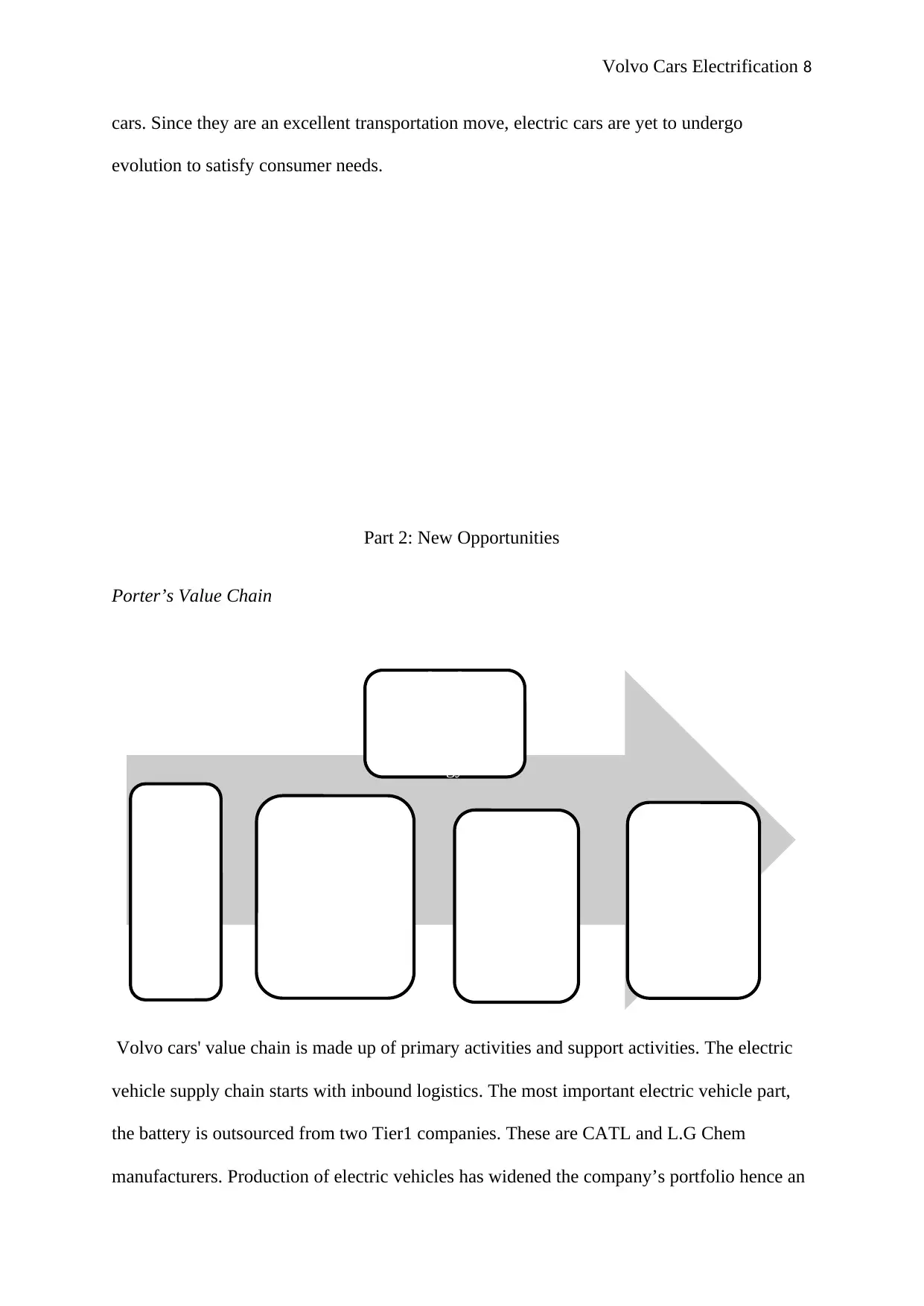
Volvo Cars Electrification 8
cars. Since they are an excellent transportation move, electric cars are yet to undergo
evolution to satisfy consumer needs.
Part 2: New Opportunities
Porter’s Value Chain
Volvo cars' value chain is made up of primary activities and support activities. The electric
vehicle supply chain starts with inbound logistics. The most important electric vehicle part,
the battery is outsourced from two Tier1 companies. These are CATL and L.G Chem
manufacturers. Production of electric vehicles has widened the company’s portfolio hence an
Inbound
logistics
-CATL
and L.G
Chem
battery
manufact
urers
Production
-New Production
line at Ghent
-BIW production
lines
-Parts
remanufacturing
Outbound
Logistics
-Vehicle
yards at
Torslanda
-Road, ship
and rail
distribution.
Marketing
and services
-Brand
advertising
-Motor shows
-Online sale
of products
Technology
-G-log Logistics
software
-Blockchain
Technology
cars. Since they are an excellent transportation move, electric cars are yet to undergo
evolution to satisfy consumer needs.
Part 2: New Opportunities
Porter’s Value Chain
Volvo cars' value chain is made up of primary activities and support activities. The electric
vehicle supply chain starts with inbound logistics. The most important electric vehicle part,
the battery is outsourced from two Tier1 companies. These are CATL and L.G Chem
manufacturers. Production of electric vehicles has widened the company’s portfolio hence an
Inbound
logistics
-CATL
and L.G
Chem
battery
manufact
urers
Production
-New Production
line at Ghent
-BIW production
lines
-Parts
remanufacturing
Outbound
Logistics
-Vehicle
yards at
Torslanda
-Road, ship
and rail
distribution.
Marketing
and services
-Brand
advertising
-Motor shows
-Online sale
of products
Technology
-G-log Logistics
software
-Blockchain
Technology
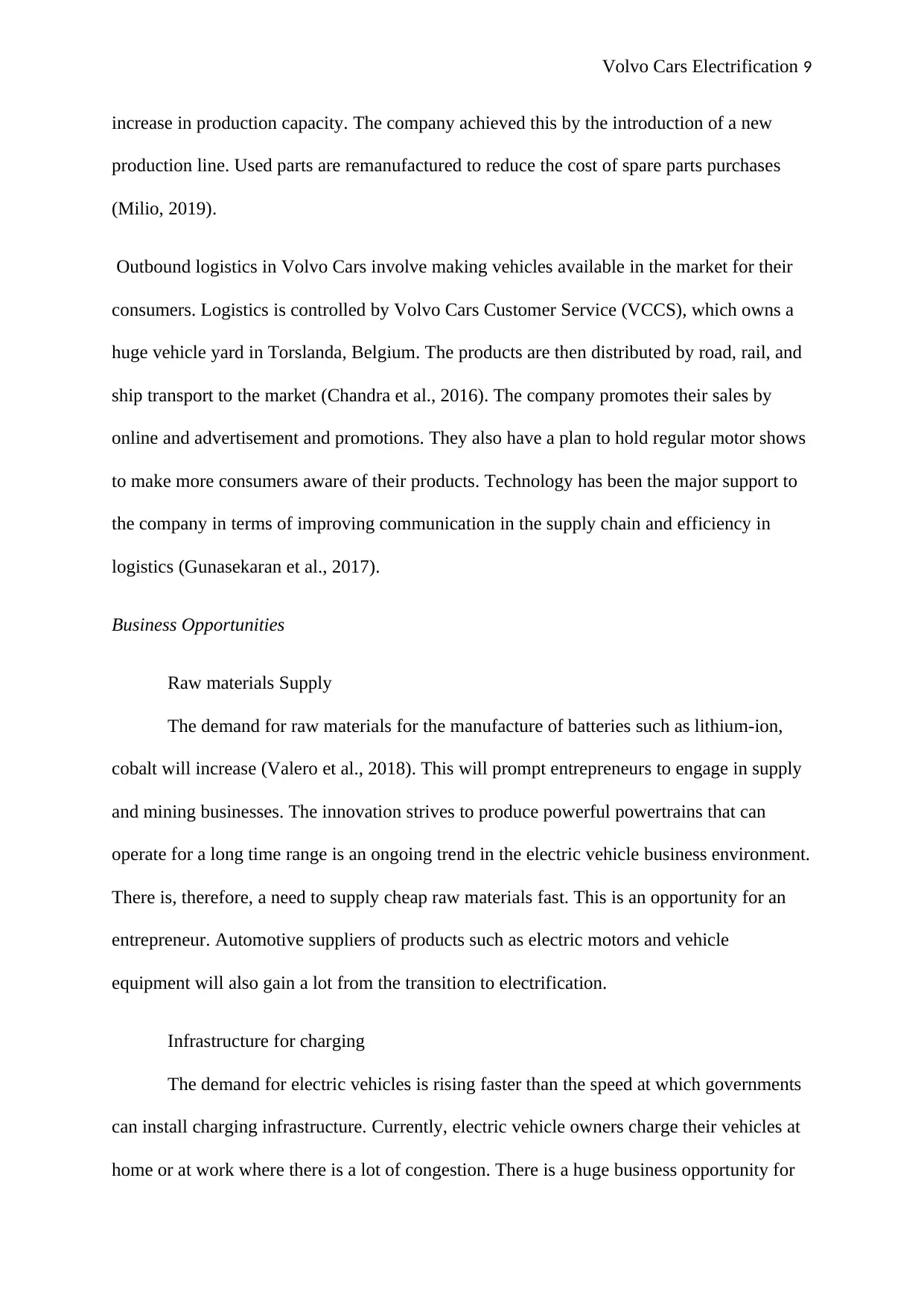
Volvo Cars Electrification 9
increase in production capacity. The company achieved this by the introduction of a new
production line. Used parts are remanufactured to reduce the cost of spare parts purchases
(Milio, 2019).
Outbound logistics in Volvo Cars involve making vehicles available in the market for their
consumers. Logistics is controlled by Volvo Cars Customer Service (VCCS), which owns a
huge vehicle yard in Torslanda, Belgium. The products are then distributed by road, rail, and
ship transport to the market (Chandra et al., 2016). The company promotes their sales by
online and advertisement and promotions. They also have a plan to hold regular motor shows
to make more consumers aware of their products. Technology has been the major support to
the company in terms of improving communication in the supply chain and efficiency in
logistics (Gunasekaran et al., 2017).
Business Opportunities
Raw materials Supply
The demand for raw materials for the manufacture of batteries such as lithium-ion,
cobalt will increase (Valero et al., 2018). This will prompt entrepreneurs to engage in supply
and mining businesses. The innovation strives to produce powerful powertrains that can
operate for a long time range is an ongoing trend in the electric vehicle business environment.
There is, therefore, a need to supply cheap raw materials fast. This is an opportunity for an
entrepreneur. Automotive suppliers of products such as electric motors and vehicle
equipment will also gain a lot from the transition to electrification.
Infrastructure for charging
The demand for electric vehicles is rising faster than the speed at which governments
can install charging infrastructure. Currently, electric vehicle owners charge their vehicles at
home or at work where there is a lot of congestion. There is a huge business opportunity for
increase in production capacity. The company achieved this by the introduction of a new
production line. Used parts are remanufactured to reduce the cost of spare parts purchases
(Milio, 2019).
Outbound logistics in Volvo Cars involve making vehicles available in the market for their
consumers. Logistics is controlled by Volvo Cars Customer Service (VCCS), which owns a
huge vehicle yard in Torslanda, Belgium. The products are then distributed by road, rail, and
ship transport to the market (Chandra et al., 2016). The company promotes their sales by
online and advertisement and promotions. They also have a plan to hold regular motor shows
to make more consumers aware of their products. Technology has been the major support to
the company in terms of improving communication in the supply chain and efficiency in
logistics (Gunasekaran et al., 2017).
Business Opportunities
Raw materials Supply
The demand for raw materials for the manufacture of batteries such as lithium-ion,
cobalt will increase (Valero et al., 2018). This will prompt entrepreneurs to engage in supply
and mining businesses. The innovation strives to produce powerful powertrains that can
operate for a long time range is an ongoing trend in the electric vehicle business environment.
There is, therefore, a need to supply cheap raw materials fast. This is an opportunity for an
entrepreneur. Automotive suppliers of products such as electric motors and vehicle
equipment will also gain a lot from the transition to electrification.
Infrastructure for charging
The demand for electric vehicles is rising faster than the speed at which governments
can install charging infrastructure. Currently, electric vehicle owners charge their vehicles at
home or at work where there is a lot of congestion. There is a huge business opportunity for

Volvo Cars Electrification 10
entrepreneurs to put up hardware facilities for charging systems and batteries, maintenance,
and installation services. Charging stations are also in huge demand (Enge et al., 2018). This
is because the short time range of batteries does not allow long-distance travel. There is a
need, therefore, to put up charging stations nearby along highways to enable users to charge
their systems as they travel.
Customer support services
The increase in services such as charging stations paves the way for services such as
payment and billing services for banks and information technology providers. Charging of an
electric vehicle takes an average of 20 to 30 minutes. Owners will have to wait for this long
before proceeding in their journey. They will need places to rest and obtain refreshments.
This is an opportunity for fast-food restaurants, hotels, and convenience stores (Ahmed,
2019). In general, the transition towards electrification offers a huge opportunity for
entrepreneurs for businesses that are both, directly and indirectly connected to electric vehicle
manufacture.
Business discontinuation
Internal Combustion Engines supply
Introduction of electric vehicles will cause a huge reduction in demand for ICE
vehicles (Burch, 2018). With this, many vehicle manufacturers will stop their production of
these vehicles. For example, Volvo Cars intend to stop by 2040 completely. Their need for
internal combustion engines will drastically stop. Suppliers for these engines and for spare
parts that are associated with ICE vehicles will run out of business. To mitigate this risk,
these suppliers may invest in parts and equipment related to the electric vehicle power train.
This way, they will still be in operation during complete transition.
entrepreneurs to put up hardware facilities for charging systems and batteries, maintenance,
and installation services. Charging stations are also in huge demand (Enge et al., 2018). This
is because the short time range of batteries does not allow long-distance travel. There is a
need, therefore, to put up charging stations nearby along highways to enable users to charge
their systems as they travel.
Customer support services
The increase in services such as charging stations paves the way for services such as
payment and billing services for banks and information technology providers. Charging of an
electric vehicle takes an average of 20 to 30 minutes. Owners will have to wait for this long
before proceeding in their journey. They will need places to rest and obtain refreshments.
This is an opportunity for fast-food restaurants, hotels, and convenience stores (Ahmed,
2019). In general, the transition towards electrification offers a huge opportunity for
entrepreneurs for businesses that are both, directly and indirectly connected to electric vehicle
manufacture.
Business discontinuation
Internal Combustion Engines supply
Introduction of electric vehicles will cause a huge reduction in demand for ICE
vehicles (Burch, 2018). With this, many vehicle manufacturers will stop their production of
these vehicles. For example, Volvo Cars intend to stop by 2040 completely. Their need for
internal combustion engines will drastically stop. Suppliers for these engines and for spare
parts that are associated with ICE vehicles will run out of business. To mitigate this risk,
these suppliers may invest in parts and equipment related to the electric vehicle power train.
This way, they will still be in operation during complete transition.
Secure Best Marks with AI Grader
Need help grading? Try our AI Grader for instant feedback on your assignments.
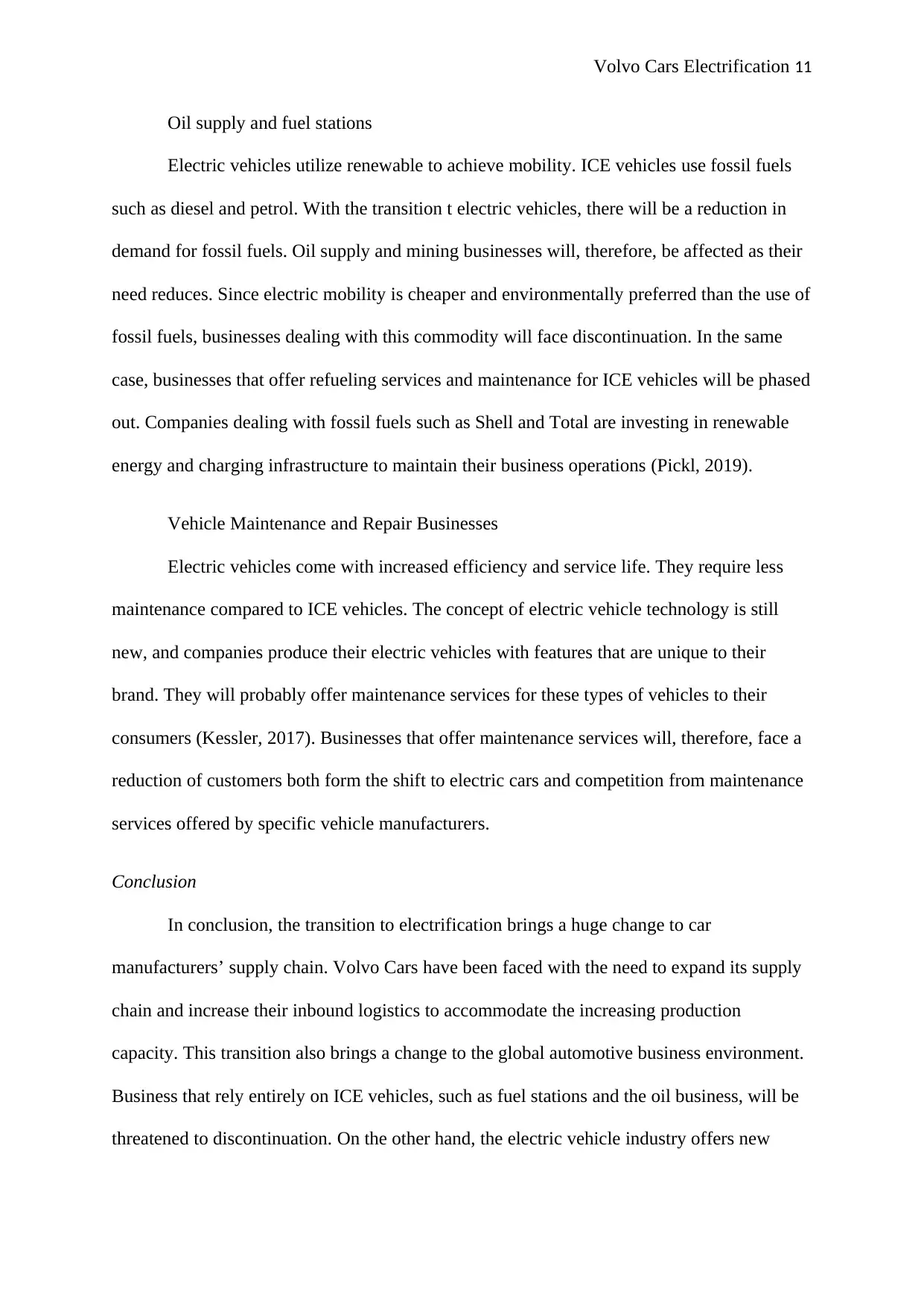
Volvo Cars Electrification 11
Oil supply and fuel stations
Electric vehicles utilize renewable to achieve mobility. ICE vehicles use fossil fuels
such as diesel and petrol. With the transition t electric vehicles, there will be a reduction in
demand for fossil fuels. Oil supply and mining businesses will, therefore, be affected as their
need reduces. Since electric mobility is cheaper and environmentally preferred than the use of
fossil fuels, businesses dealing with this commodity will face discontinuation. In the same
case, businesses that offer refueling services and maintenance for ICE vehicles will be phased
out. Companies dealing with fossil fuels such as Shell and Total are investing in renewable
energy and charging infrastructure to maintain their business operations (Pickl, 2019).
Vehicle Maintenance and Repair Businesses
Electric vehicles come with increased efficiency and service life. They require less
maintenance compared to ICE vehicles. The concept of electric vehicle technology is still
new, and companies produce their electric vehicles with features that are unique to their
brand. They will probably offer maintenance services for these types of vehicles to their
consumers (Kessler, 2017). Businesses that offer maintenance services will, therefore, face a
reduction of customers both form the shift to electric cars and competition from maintenance
services offered by specific vehicle manufacturers.
Conclusion
In conclusion, the transition to electrification brings a huge change to car
manufacturers’ supply chain. Volvo Cars have been faced with the need to expand its supply
chain and increase their inbound logistics to accommodate the increasing production
capacity. This transition also brings a change to the global automotive business environment.
Business that rely entirely on ICE vehicles, such as fuel stations and the oil business, will be
threatened to discontinuation. On the other hand, the electric vehicle industry offers new
Oil supply and fuel stations
Electric vehicles utilize renewable to achieve mobility. ICE vehicles use fossil fuels
such as diesel and petrol. With the transition t electric vehicles, there will be a reduction in
demand for fossil fuels. Oil supply and mining businesses will, therefore, be affected as their
need reduces. Since electric mobility is cheaper and environmentally preferred than the use of
fossil fuels, businesses dealing with this commodity will face discontinuation. In the same
case, businesses that offer refueling services and maintenance for ICE vehicles will be phased
out. Companies dealing with fossil fuels such as Shell and Total are investing in renewable
energy and charging infrastructure to maintain their business operations (Pickl, 2019).
Vehicle Maintenance and Repair Businesses
Electric vehicles come with increased efficiency and service life. They require less
maintenance compared to ICE vehicles. The concept of electric vehicle technology is still
new, and companies produce their electric vehicles with features that are unique to their
brand. They will probably offer maintenance services for these types of vehicles to their
consumers (Kessler, 2017). Businesses that offer maintenance services will, therefore, face a
reduction of customers both form the shift to electric cars and competition from maintenance
services offered by specific vehicle manufacturers.
Conclusion
In conclusion, the transition to electrification brings a huge change to car
manufacturers’ supply chain. Volvo Cars have been faced with the need to expand its supply
chain and increase their inbound logistics to accommodate the increasing production
capacity. This transition also brings a change to the global automotive business environment.
Business that rely entirely on ICE vehicles, such as fuel stations and the oil business, will be
threatened to discontinuation. On the other hand, the electric vehicle industry offers new
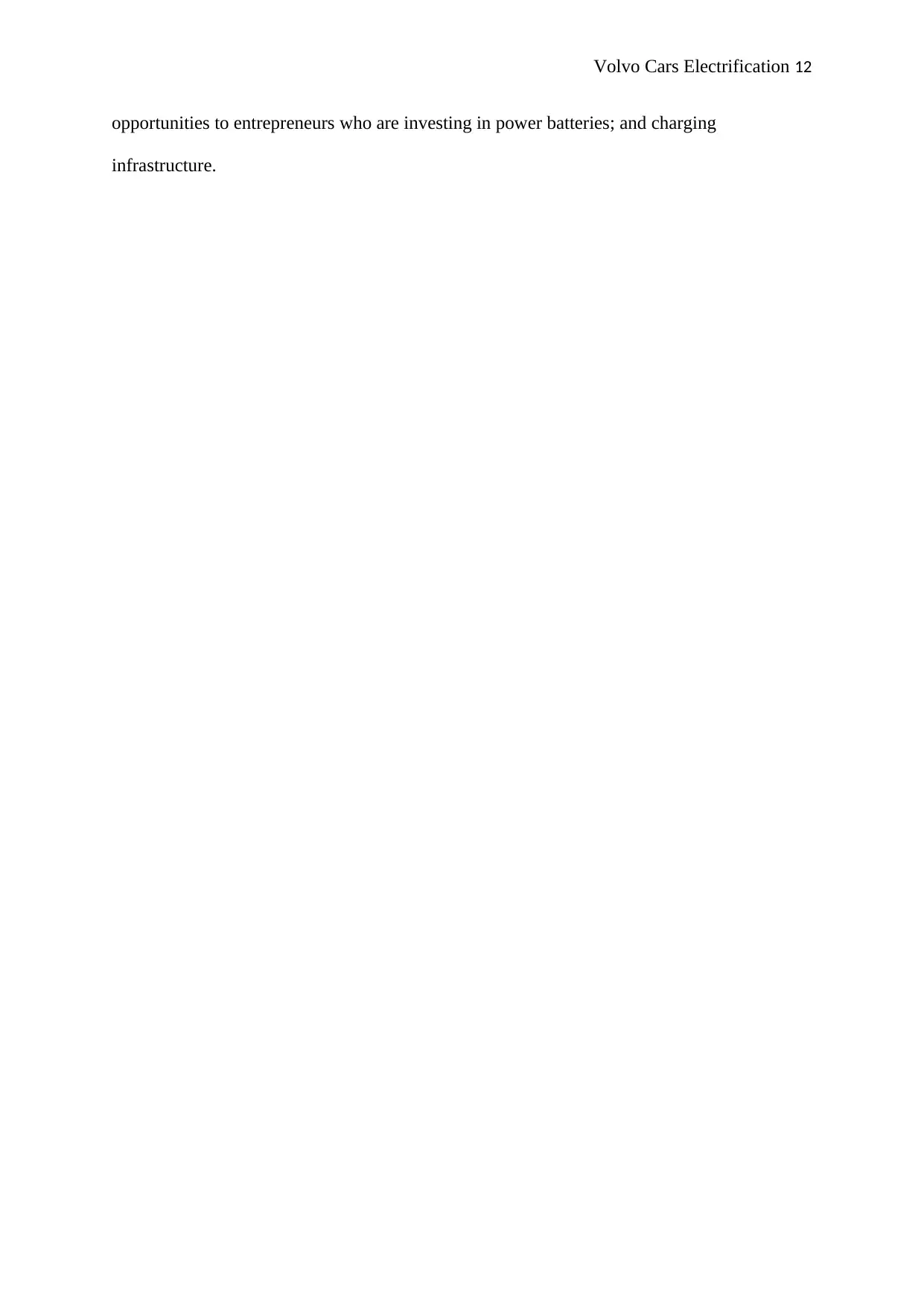
Volvo Cars Electrification 12
opportunities to entrepreneurs who are investing in power batteries; and charging
infrastructure.
opportunities to entrepreneurs who are investing in power batteries; and charging
infrastructure.
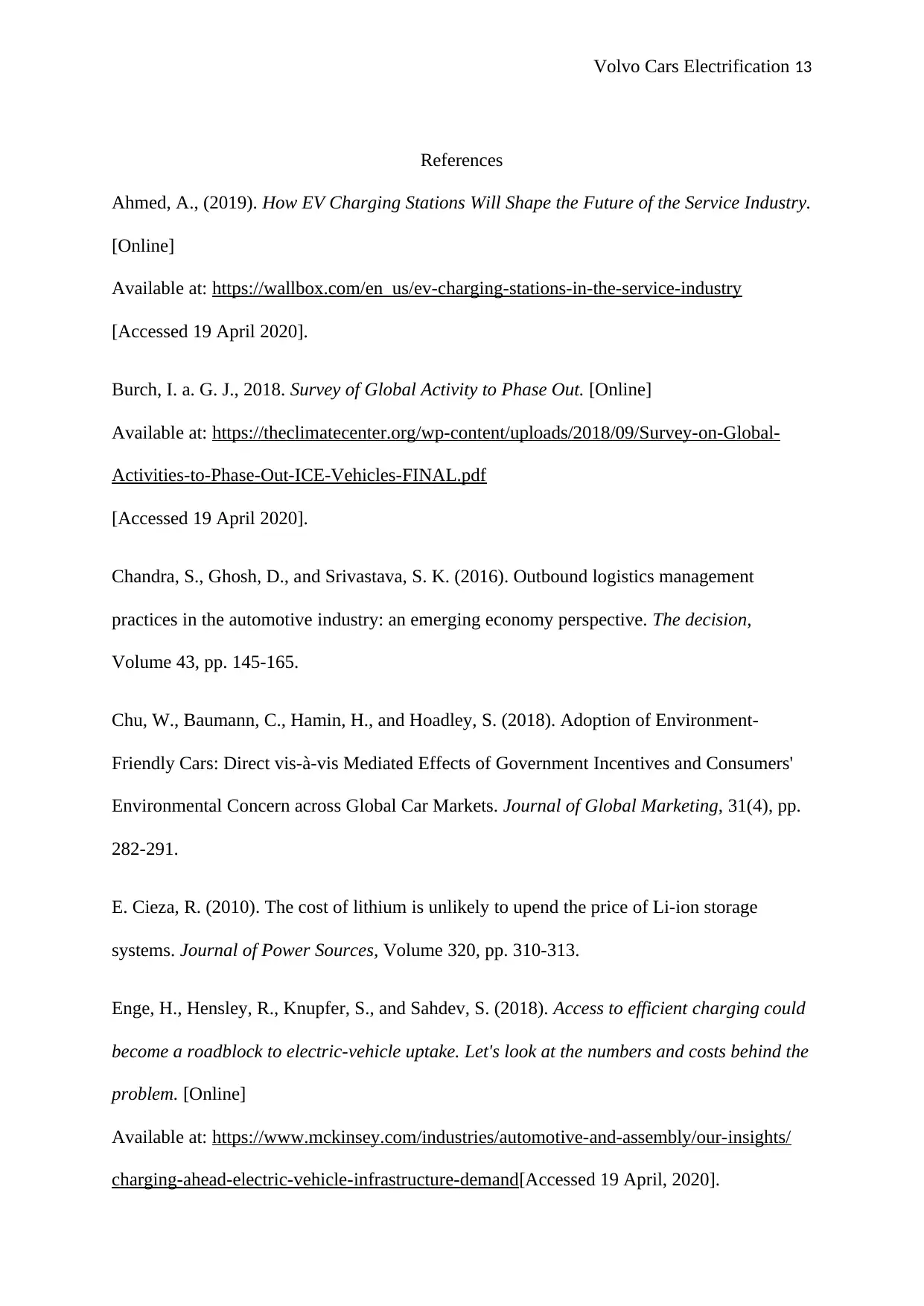
Volvo Cars Electrification 13
References
Ahmed, A., (2019). How EV Charging Stations Will Shape the Future of the Service Industry.
[Online]
Available at: https://wallbox.com/en_us/ev-charging-stations-in-the-service-industry
[Accessed 19 April 2020].
Burch, I. a. G. J., 2018. Survey of Global Activity to Phase Out. [Online]
Available at: https://theclimatecenter.org/wp-content/uploads/2018/09/Survey-on-Global-
Activities-to-Phase-Out-ICE-Vehicles-FINAL.pdf
[Accessed 19 April 2020].
Chandra, S., Ghosh, D., and Srivastava, S. K. (2016). Outbound logistics management
practices in the automotive industry: an emerging economy perspective. The decision,
Volume 43, pp. 145-165.
Chu, W., Baumann, C., Hamin, H., and Hoadley, S. (2018). Adoption of Environment-
Friendly Cars: Direct vis-à-vis Mediated Effects of Government Incentives and Consumers'
Environmental Concern across Global Car Markets. Journal of Global Marketing, 31(4), pp.
282-291.
E. Cieza, R. (2010). The cost of lithium is unlikely to upend the price of Li-ion storage
systems. Journal of Power Sources, Volume 320, pp. 310-313.
Enge, H., Hensley, R., Knupfer, S., and Sahdev, S. (2018). Access to efficient charging could
become a roadblock to electric-vehicle uptake. Let's look at the numbers and costs behind the
problem. [Online]
Available at: https://www.mckinsey.com/industries/automotive-and-assembly/our-insights/
charging-ahead-electric-vehicle-infrastructure-demand[Accessed 19 April, 2020].
References
Ahmed, A., (2019). How EV Charging Stations Will Shape the Future of the Service Industry.
[Online]
Available at: https://wallbox.com/en_us/ev-charging-stations-in-the-service-industry
[Accessed 19 April 2020].
Burch, I. a. G. J., 2018. Survey of Global Activity to Phase Out. [Online]
Available at: https://theclimatecenter.org/wp-content/uploads/2018/09/Survey-on-Global-
Activities-to-Phase-Out-ICE-Vehicles-FINAL.pdf
[Accessed 19 April 2020].
Chandra, S., Ghosh, D., and Srivastava, S. K. (2016). Outbound logistics management
practices in the automotive industry: an emerging economy perspective. The decision,
Volume 43, pp. 145-165.
Chu, W., Baumann, C., Hamin, H., and Hoadley, S. (2018). Adoption of Environment-
Friendly Cars: Direct vis-à-vis Mediated Effects of Government Incentives and Consumers'
Environmental Concern across Global Car Markets. Journal of Global Marketing, 31(4), pp.
282-291.
E. Cieza, R. (2010). The cost of lithium is unlikely to upend the price of Li-ion storage
systems. Journal of Power Sources, Volume 320, pp. 310-313.
Enge, H., Hensley, R., Knupfer, S., and Sahdev, S. (2018). Access to efficient charging could
become a roadblock to electric-vehicle uptake. Let's look at the numbers and costs behind the
problem. [Online]
Available at: https://www.mckinsey.com/industries/automotive-and-assembly/our-insights/
charging-ahead-electric-vehicle-infrastructure-demand[Accessed 19 April, 2020].
Paraphrase This Document
Need a fresh take? Get an instant paraphrase of this document with our AI Paraphraser

Volvo Cars Electrification 14
Gunasekaran, A. l., Subramanian, N. and Papadopoulos, T., (2017). Information technology
for competitive advantage within logistics and supply chains: A review. Transportation
Research Part E: Logistics and Transportation Review, Volume 99, pp. 14-33.
Kessler, S. (2017). The connected car of the future could kill off the local auto repair shop.
[Online]
Available at: https://qz.com/1054261/the-connected-car-of-the-future-could-kill-off-the-
local-auto-repair-shop/[Accessed 19 April, 2020].
Loureiro, S. M. C., Sarmento, E. M., Bellego, G. L., and Wright, L. T., (2017). The effect of
corporate brand reputation on brand attachment and brand loyalty: The automobile sector.
Cogent Business and Management, 4(1).
Masiero, G., Ogasawara, M. H. and Jussani, A. C. a. R. M. L. (2016). Electric vehicles in
China: BYD strategies and government subsidies. RAI Revista de Administração e Inovação,
13(1), pp. 3-11.
Meckling, J. a. N. J. (2019). The politics of technology bans: Industrial policy competition
and green goals for the auto industry. Energy Policy, Volume 126, pp. 470-479.
Miao, Y., Hynan, P., Jouanne, A. v. and Yokochi, A. (2019). Current Li-Ion Battery
Technologies in Electric Vehicles and Opportunities for Advancements. Energies, 12(6), p.
1074.
Milio, L. a. M. M. (2019). Consumer Perception of Remanufactured Automotive Parts and
Policy Implications for Transitioning to a Circular Economy in Sweden. Sustainability,
11(22), p. 6264.
Pickl, M. J. (2019). The renewable energy strategies of oil majors – From oil to energy?.
Energy Strategy Reviews, Volume 26.
Gunasekaran, A. l., Subramanian, N. and Papadopoulos, T., (2017). Information technology
for competitive advantage within logistics and supply chains: A review. Transportation
Research Part E: Logistics and Transportation Review, Volume 99, pp. 14-33.
Kessler, S. (2017). The connected car of the future could kill off the local auto repair shop.
[Online]
Available at: https://qz.com/1054261/the-connected-car-of-the-future-could-kill-off-the-
local-auto-repair-shop/[Accessed 19 April, 2020].
Loureiro, S. M. C., Sarmento, E. M., Bellego, G. L., and Wright, L. T., (2017). The effect of
corporate brand reputation on brand attachment and brand loyalty: The automobile sector.
Cogent Business and Management, 4(1).
Masiero, G., Ogasawara, M. H. and Jussani, A. C. a. R. M. L. (2016). Electric vehicles in
China: BYD strategies and government subsidies. RAI Revista de Administração e Inovação,
13(1), pp. 3-11.
Meckling, J. a. N. J. (2019). The politics of technology bans: Industrial policy competition
and green goals for the auto industry. Energy Policy, Volume 126, pp. 470-479.
Miao, Y., Hynan, P., Jouanne, A. v. and Yokochi, A. (2019). Current Li-Ion Battery
Technologies in Electric Vehicles and Opportunities for Advancements. Energies, 12(6), p.
1074.
Milio, L. a. M. M. (2019). Consumer Perception of Remanufactured Automotive Parts and
Policy Implications for Transitioning to a Circular Economy in Sweden. Sustainability,
11(22), p. 6264.
Pickl, M. J. (2019). The renewable energy strategies of oil majors – From oil to energy?.
Energy Strategy Reviews, Volume 26.
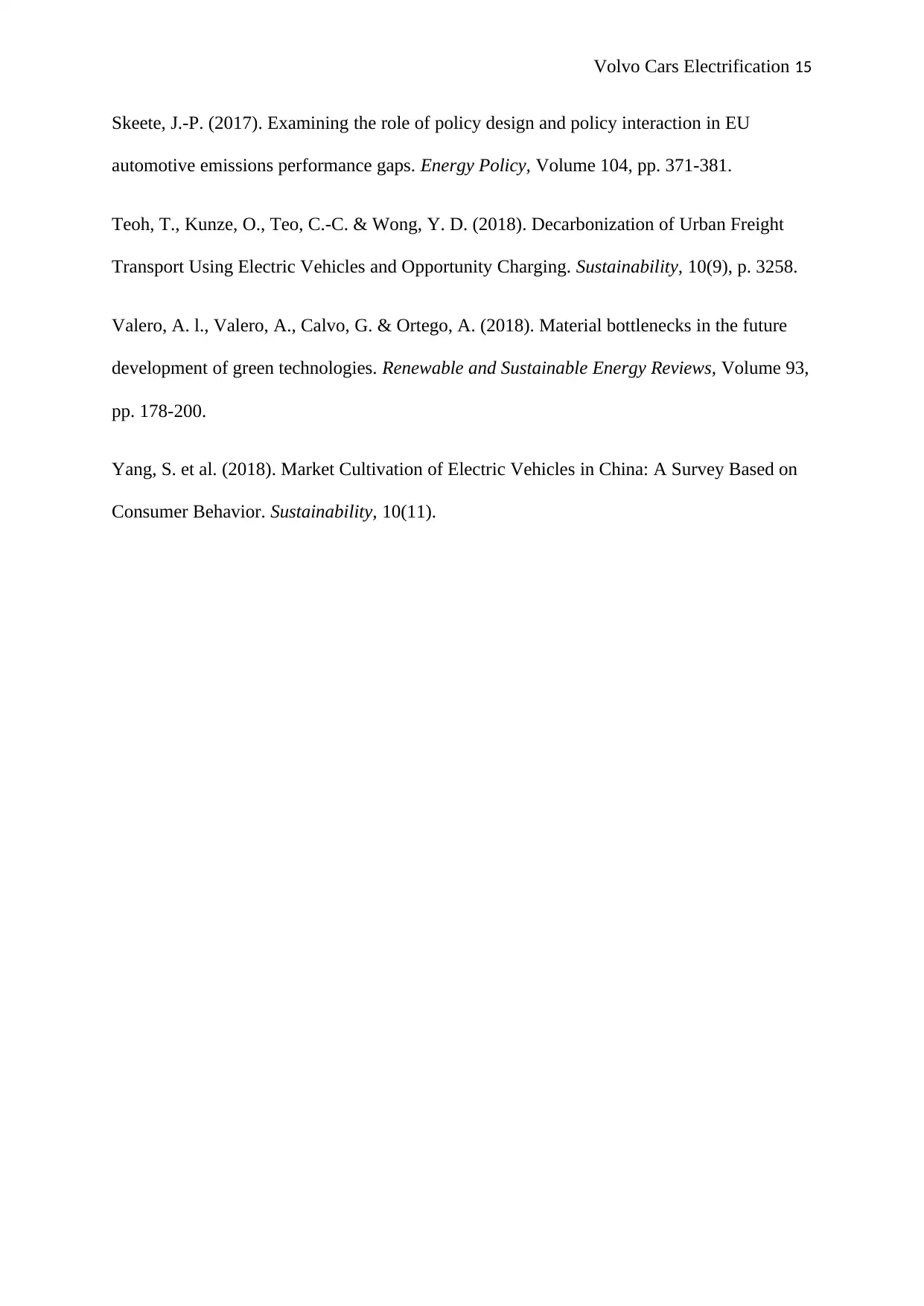
Volvo Cars Electrification 15
Skeete, J.-P. (2017). Examining the role of policy design and policy interaction in EU
automotive emissions performance gaps. Energy Policy, Volume 104, pp. 371-381.
Teoh, T., Kunze, O., Teo, C.-C. & Wong, Y. D. (2018). Decarbonization of Urban Freight
Transport Using Electric Vehicles and Opportunity Charging. Sustainability, 10(9), p. 3258.
Valero, A. l., Valero, A., Calvo, G. & Ortego, A. (2018). Material bottlenecks in the future
development of green technologies. Renewable and Sustainable Energy Reviews, Volume 93,
pp. 178-200.
Yang, S. et al. (2018). Market Cultivation of Electric Vehicles in China: A Survey Based on
Consumer Behavior. Sustainability, 10(11).
Skeete, J.-P. (2017). Examining the role of policy design and policy interaction in EU
automotive emissions performance gaps. Energy Policy, Volume 104, pp. 371-381.
Teoh, T., Kunze, O., Teo, C.-C. & Wong, Y. D. (2018). Decarbonization of Urban Freight
Transport Using Electric Vehicles and Opportunity Charging. Sustainability, 10(9), p. 3258.
Valero, A. l., Valero, A., Calvo, G. & Ortego, A. (2018). Material bottlenecks in the future
development of green technologies. Renewable and Sustainable Energy Reviews, Volume 93,
pp. 178-200.
Yang, S. et al. (2018). Market Cultivation of Electric Vehicles in China: A Survey Based on
Consumer Behavior. Sustainability, 10(11).
1 out of 15
Related Documents
Your All-in-One AI-Powered Toolkit for Academic Success.
+13062052269
info@desklib.com
Available 24*7 on WhatsApp / Email
![[object Object]](/_next/static/media/star-bottom.7253800d.svg)
Unlock your academic potential
© 2024 | Zucol Services PVT LTD | All rights reserved.





